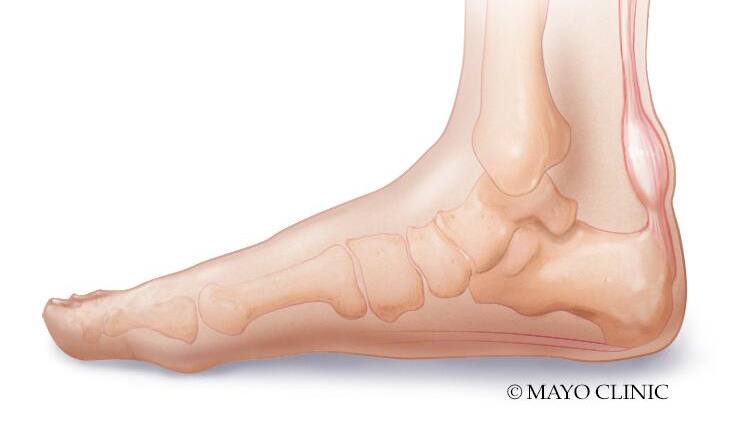-
Health and Wellness

LA CROSSE, Wis. — The warm summer weather is making adults feel like kids again. It’s bringing out the weekend sports crowds in force, and the excitement and intensity of exercise can lead to an all-too-common injury among this group: Achilles tendonitis.
“Achilles tendonitis is most common in people who suddenly increase the intensity or duration of their exercise, and it also commonly occurs when people don’t train properly for their sport,” says Jacob Erickson, MD, a sports medicine physician at Mayo Clinic Health System.
The Achilles tendon is a long band of tissue that connects the calf muscles at the back of the lower leg to the heel bone. This tendon is used when walking, running, jumping, and pushing off with your toes. However, when this tendon is injured, it can cause pain and dysfunction in the back of the calf, and can prevent you from walking for months.
Being aware of your risks for Achilles tendonitis and knowing how to prevent it can help you walk, run and exercise without pain. Risk factors include:
- Your gender
Achilles tendonitis is most common in men. - Year
The risk increases as you get older. - Flat feet
When the arch of your foot naturally flattens, it puts more strain on your Achilles tendon. - obesity
Carrying extra weight also puts increased strain on tendons. - Inappropriate footwear
Running in worn-down shoes or wearing footwear that is not suitable for sports can injure tendons. - Weather and terrain
Tendon pain is more likely to occur in cold weather than in warm weather, and running hills puts additional strain on your Achilles tendon. - Medical Conditions and Medication
People with psoriasis or high blood pressure, or who take certain types of antibiotics called fluoroquinolones, are at higher risk of developing Achilles tendonitis.
“Although there is a risk for this type of injury, there are things you can do to prevent it,” says Dr. Erickson. “For example, if you are beginning an exercise regimen, start slowly and gradually increase the duration and intensity of your training.”
Other tips include avoiding activities that put too much strain on the tendons, such as hill running. If you are going to take part in strenuous exercise, warm up first by exercising at a slow pace. If you feel pain during a particular exercise, stop and rest.
Choose your shoes carefully. The shoes you wear while exercising should provide adequate cushioning in the heel and good arch support to relieve tension in your Achilles tendon. Replace worn-out shoes. If your shoes are in good condition but don’t provide arch support, try adding more support to both shoes.
To keep your calf muscles and Achilles tendons flexible, take the time to stretch them in the morning, before and after exercise. This is especially important to prevent Achilles tendonitis from recurring.
Strengthen your calf muscles. Stronger calf muscles help your calf and Achilles tendon better cope with the stresses of activity and exercise.
“If you injure your Achilles tendon, be sure to rest and avoid exercising the area,” says Dr. Erickson. “It’s important to recognize pain early and avoid exercising while you have pain. Ignoring the pain and continuing to exercise can make the problem worse and potentially become chronic. Early recognition, rest, and basic stretching can help improve the problem quickly.”
If symptoms don’t subside after a few weeks, contact your healthcare team. Early treatment may include more intensive physical therapy exercises or localized treatments to relieve pain.
Achilles tendonitis can become chronic if not treated early and appropriately, lasting for months or even years. If Achilles tendon pain is persistent, surgery may be required to repair the tendon. Healing can take several months, so it’s best to be aware of the risks and take precautions to stay pain-free and active.
###
About Mayo Clinic Health System
The Mayo Clinic Health System is made up of clinics, hospitals and other facilities that serve the health care needs of people across Minnesota and Wisconsin. By combining community-based health professionals with the resources and expertise of Mayo Clinic, area patients can receive the highest quality physical and virtual care close to home.
Media Contact:
- Amanda Dislin, Mayo Clinic Health System Communications, newsbureau@mayo.edu


